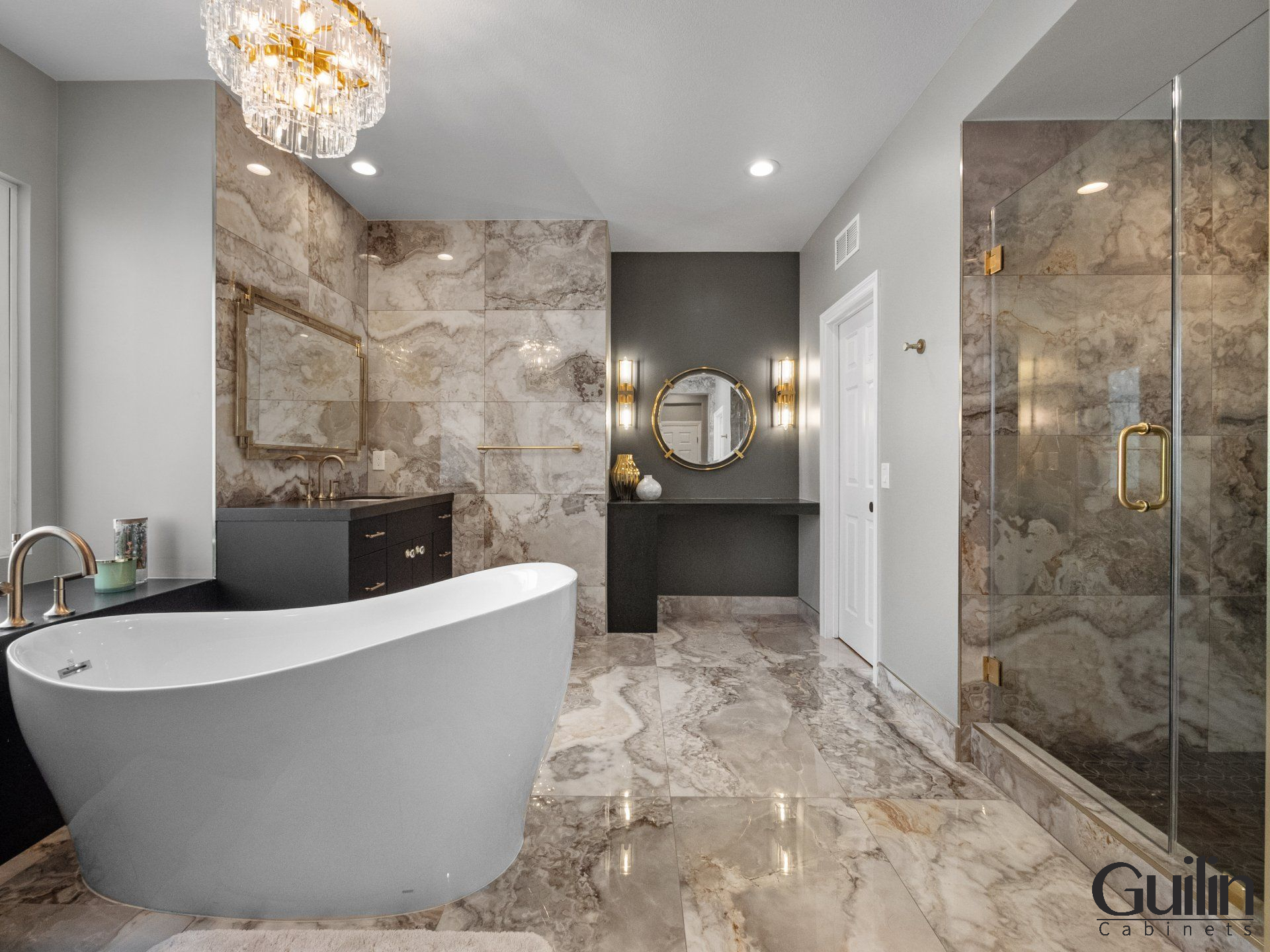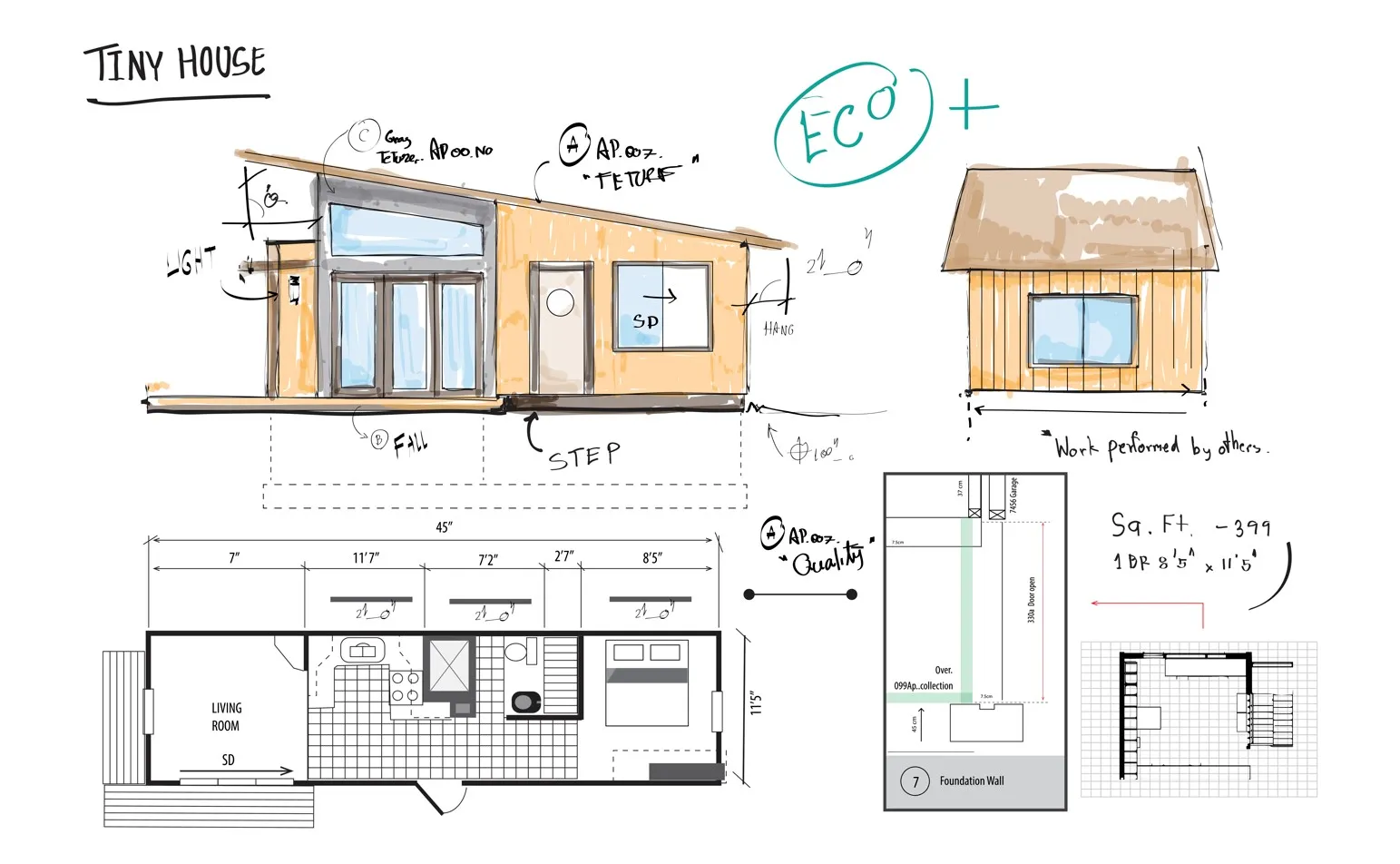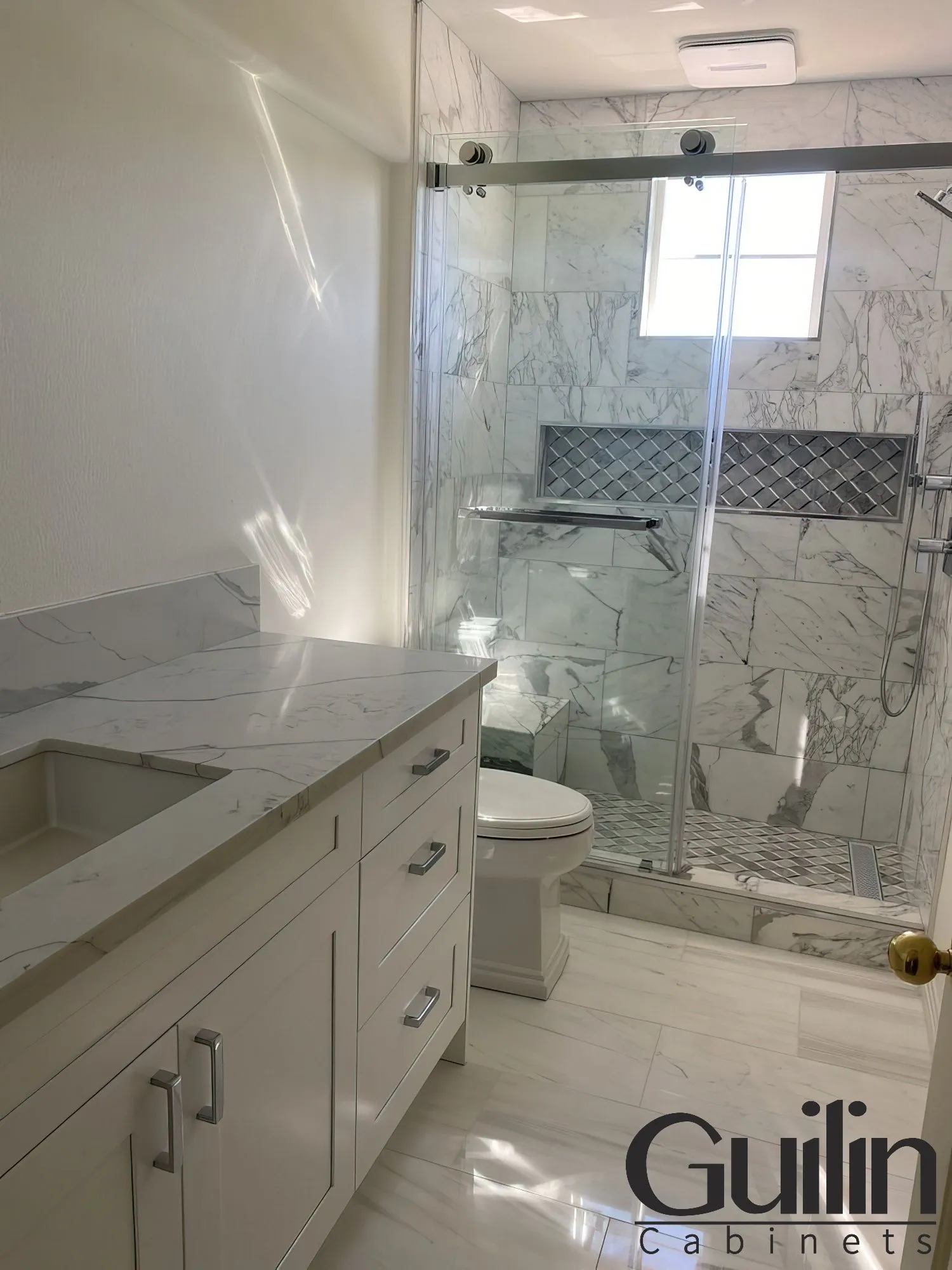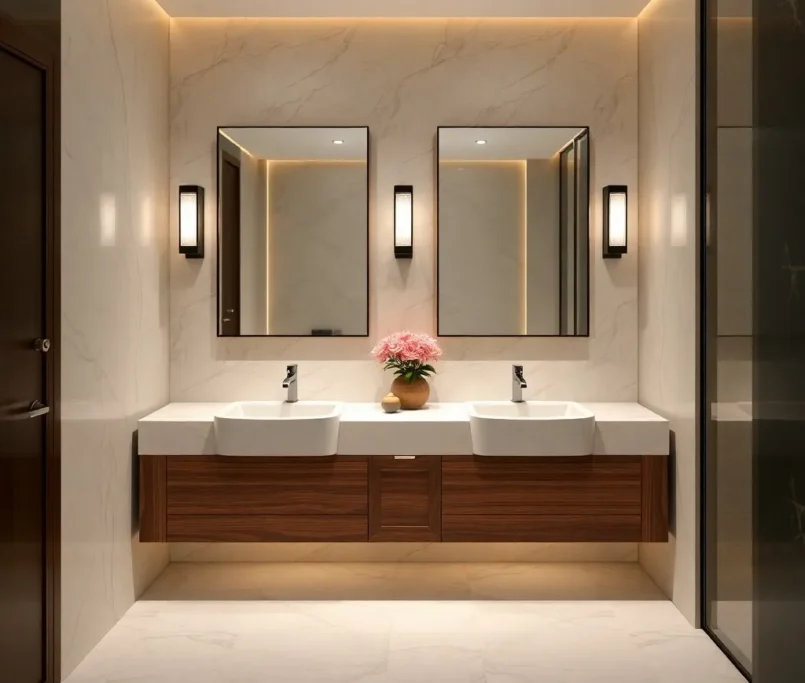You might be considering expanding your half bath to a full bath to increase both functionality and home value. Converting your bathroom involves careful planning, including assessing your space, updating plumbing and electrical systems, and obtaining proper permits. While the renovation can be complex and require structural changes, working with experienced professionals ensures your project meets safety standards and design goals. By following the right steps, you can transform your bathroom into a comfortable, fully equipped space that meets your needs and enhances your home’s appeal.
About Bathroom Types
Before we get started on the conversion process, let’s clarify the difference between a half bath and a full bath. Firstly, count the number of water-bearing features in the bathroom. These include the sink, toilet, tub, and shower. Each of these features counts as one-quarter of a bathroom.
- Full Bath (known as the master bathroom): A bathroom that has all four features – sink, toilet, tub, and shower – is classified as a full bath.
- Half Bath (known as guest bathroom, powder bathroom): It’s also known as a powder room, and has only two features – a sink and a toilet – is classified as a Half bath.
| Bathroom Type | Main Fixtures |
|---|---|
| Half Bath | Sink, Toilet |
| Three-Quarter Bath | Sink, Toilet, Shower |
| Full Bath | Sink, Toilet, Bathtub, Shower (or tub/shower combo) |
| Common Use | Guest or Powder Room |
| Typical Size Range | 10-20 square feet (half bath), 35-40 square feet (full bath) |
=> Related Article: Santa Ana Bathroom Remodel: Converting Bathtub to Walk-In Shower


Half Bath vs. Full Bath
Beside simply the number of fixtures, understanding the difference between a half bath and a full bath is important when planning your conversion project. A half bath, also known as a powder room, typically contains only a sink and toilet and occupies minimal space. In contrast, a full bath includes a bathtub or shower, in addition to a sink and toilet, offering greater functionality and convenience.
Adding a full bath can dramatically enhance your home’s livability and value, but it requires careful planning due to space and plumbing demands. Compared to a half bath, a full bath requires more complex plumbing and electrical systems, which affects the scope and cost of your renovation.
6 Steps For Converting a Half Bath to a Full Bath:
Converting a half-bath into a full bathtub requires a significant renovation effort. Still, the process usually involves these 6 fundamental Steps.
- Assessing Your Kitchen Space
- Check Your Plumbing & Electrical Sytems
- Obtaining Necessary Permits
- Demolition and Structural Changes
- Plumbing and Electrical Work
- Installing Fixtures and Finishing Touches
=> Related Service: Bathroom Remodel Company In Southern California
Assessing Your Bathroom Space
But before you convert, you need to answer one important question: do you have enough space for the project? Most half baths simply don’t have enough room to add a full bathtub and shower. If you’re in this situation, you have two options: either expand the space you have or opt for a smaller setup with just a shower, also known as a 3/4 bath. If you choose to expand, you can try taking some area from an adjacent closet or room, or you can mix the bathtub and shower into one space to save even more space.
The Common Haft Bathrooms Size:
- Small Powder Rooms: 20 to 30 square feet.
- Medium-sized Powder Rooms: 35 to 50 square feet.
The Common Full Bathrooms Size:
- Small Full Bathrooms: 30 to 35 square feet.
- Medium-sized Powder Rooms: 35 and 50 square feet.
=> Related Article: The Ideal Powder Room Size?

Check Your Plumbing & Electrical Sytems
Adding a bathtub or shower will require additional plumbing and electrical systems, That is why you need to review your current setup to ensure it can accommodate the new fixtures. The plumbing requirements for bathrooms can vary depending on the type of full bath you want to create. However, most bathrooms require a vented 2-inch drain line, a hot and cold water supply pipe, a faucet valve for the tub, and a riser pipe for the shower. In addition to plumbing, a full bath will also require additional electrical outlets. If your electrical system isn’t up to code, you may need to upgrade it to accommodate the new fixtures.

To save time and ensure everything is done right. it’s best to consult with a qualified plumber & electrical systems to know if your systems are up to par for the conversion or not. They can evaluate your current setup and determine if any upgrades or modifications to your Plumbing System are needed.

Obtaining Necessary Permits
For the next step, Permit for your renovation project. This is a very important step, You need to obtain the necessary permits from your local government before you start tearing apart walls and installing new plumbing. There are several types of permits you may need for your bathroom conversion. These can include building permits, plumbing permits, and electrical permits… you need to work with a licensed bathroom contractor or a professional remodeler who can help you navigate the permit process and ensure that everything is up to code.
=> Read More: Types of Popular Bathroom Layout Designs, Ideas

Demolition and Structural Changes
Once you have your permits in hand, it’s time you can start the demolition process. If your project needs to make major structural changes, such as moving walls or adding windows, you may need to consult with your contractor, architect, or engineer to ensure that your renovation is structurally sound.

Plumbing and Electrical Work
Once all of the demolition work & structural changes are done, you can begin to start plumbing and electrical work. This is a critical step in the renovation process, as any mistakes in the plumbing or electrical work can cause major problems down the road. It’s best you need work closely with your licensed home remodel contractor, plumber and electrician to ensure that everything is done correctly.


Installing Fixtures and Finishing Touches
Once the plumbing and electrical work is complete, it’s time to install the new fixtures and finish the space. This can include installing the bathtub or shower, tiling the walls and floor, and adding new lighting fixtures and accessories. Be sure to choose fixtures and finishes that complement your existing decor and add value to your home. A well-designed bathroom can be a major increase value point of your home.

Consider Hire a Pro Remodel Contractor
Hiring a remodeling contractor is highly beneficial when you want to convert a half bath into a full bath. Their expertise ensures complex tasks like plumbing and electrical work are handled accurately. If you’re thinking about converting a half bath into a full bath in California but aren’t sure what you need to do and what will work in your space and you need help right away. Please! Contact Guilin Cabinets Today for assistance!
- Hotline: +1 949 299 2370
- Email: info@guilincabinets.com
Knowing how important it is to get the bathroom’s layout just right, our expert bathroom remodelers are here to help you design a space that is both beautiful and practical for your family’s needs.

Contractors’ established supplier relationships and skilled labor save time and manage costs effectively. While an initial investment, their guidance prevents costly mistakes.

FAQs About Converting a Half Bath to a Full Bath?
What does converting a half bath to a full bath involve?

Converting a half bath to a full bath typically involves expanding the space to accommodate a shower or bathtub in addition to the existing toilet and sink. This may require reconfiguring the layout, adding plumbing fixtures, and making structural changes.
How long does it take to convert a half bath to a full bath?

Converting a half bath to a full bath is a significant home renovation project. The timeline for a half-bath to full-bath conversion varies depending on the scope of the renovation and the availability of contractors and materials. On average, the renovation process can take anywhere from four to eight weeks.
How much does it cost to convert a half bath to a full bath?

The cost of a half-bath to full-bath conversion can vary widely depending on the scope of the renovation and the materials used. On average, you can expect to spend between $10,000 and $30,000 for a full bathroom renovation.
Can I add a bathtub or shower to a small bathroom?

Yes, it’s possible to add a bathtub or shower to a small bathroom, but you’ll need to be strategic in your design choices. Consider choosing a smaller bathtub or a corner shower to save space. You can also opt for a shower/tub combo to maximize functionality in a small space
Do I need a building permit to convert a half bath to a full bath?

Yes, you will need a building permit to convert a half bath to a full bath. Building permits ensure that your renovation meets safety and building code requirements. Because this is a significant home renovation project. => Read More: Home Improvements That Don’t Require Permits
Do I need to hire a professional contractor?

While some homeowners may have the skills to tackle certain aspects of the conversion themselves, such as painting or tiling, it’s generally recommended to hire a professional contractor for major renovations. A contractor can ensure that the work is done safely and up to code. => Read More: Bathroom Remodel Services Irvine, Orange County
Will converting a half bath to a full bath increase my home’s value?

Adding a full bathroom can increase the value of your home, especially if it only had one bathroom previously. However, the extent of the increase will depend on factors such as the quality of the renovation, local housing market conditions, and the preferences of potential buyers. The National Association of Home Builders reports that adding a half bath can raise the value of your house by 10.5% and adding a full bath by 20%, depending on where you live. => Read More: 8 Home Improvements That Will Increase the Sale Value of Your House


















